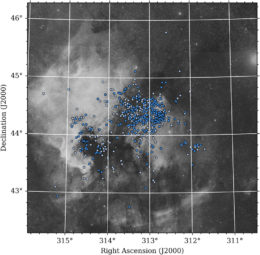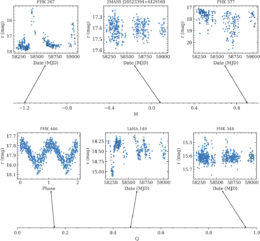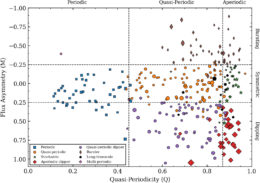Since 2018, the Zwicky Transient Facility has kept tabs on fleeting events and variable objects in the universe, scanning the entire northern sky every two days. What can this expansive survey tell us about the variability of young stellar objects?
Stellar Surveys

Full sample of young stellar objects overlaid on an image of the North America Nebula (light-colored area on the left) and the Pelican Nebula (light-colored area on the right). The final sample of variable stars is indicated by the darker blue circles. [Hillenbrand et al. 2022]
The team surveyed stars in the North America and Pelican Nebulae, which lie 2,590 light-years away in the direction of the brightest star in the constellation Cygnus. Though they bear different names, the nebulae are actually connected, separated visually by a dark band of dust. The North America and Pelican Nebulae complex contains thousands of candidate young stellar objects, dozens of which have been monitored for signs of variability. Astronomers have previously used Zwicky Transient Facility data to study individual young stellar objects, but never a large sample — until now.

Examples of light curves with low, medium, and high (from left to right) values of the flux asymmetry parameter (M, top row) and quasiperiodicity parameter (Q, bottom row). Click to enlarge. [Hillenbrand et al. 2022]
Digging In to the Data
Hillenbrand and collaborators analyzed more than two years of Zwicky Transient Facility observations of 392 young stars, searching for signs of variability and classifying each star’s quasiperiodicity and flux asymmetry. As the names suggest, quasiperiodicity refers to how periodic or random an object’s variation is, while flux asymmetry quantifies how symmetrical an object’s light curve is. Both metrics are valuable ways to describe a variable star’s behavior, distinguishing those that vary smoothly and reliably from those that suddenly and haphazardly burst or flare.
The team found that 323 of the stars in their sample vary in brightness, and 15% do so with a regular period and symmetric light curves. Another 39% of the stars have symmetric light curves but vary either quasiperiodically or randomly. Roughly 14% of the stars are “bursters” and 29% are “dippers,” with abrupt increases and decreases in brightness, respectively.
The team also examined the colors of the objects, since color changes can give us clues as to why an object’s brightness is varying. The color analysis suggested that dippers might be due to changes in the dusty, light-absorbing material surrounding the young stars, while bursters may signal accretion episodes.
Broad Applicability

Categorizations of all stars in the sample according to their flux asymmetry and quasiperiodicity. Click to enlarge. [Hillenbrand et al. 2022]
This study marks the first time that Zwicky Transient Facility data have been used to investigate a large sample of young stellar objects, but surely not the last — be on the lookout for more exciting results from this survey!
Citation
“A Zwicky Transient Facility Look at Optical Variability of Young Stellar Objects in the North America and Pelican Nebulae Complex,” Lynne A. Hillenbrand et al 2022 AJ 163 263. doi:10.3847/1538-3881/ac62d8

